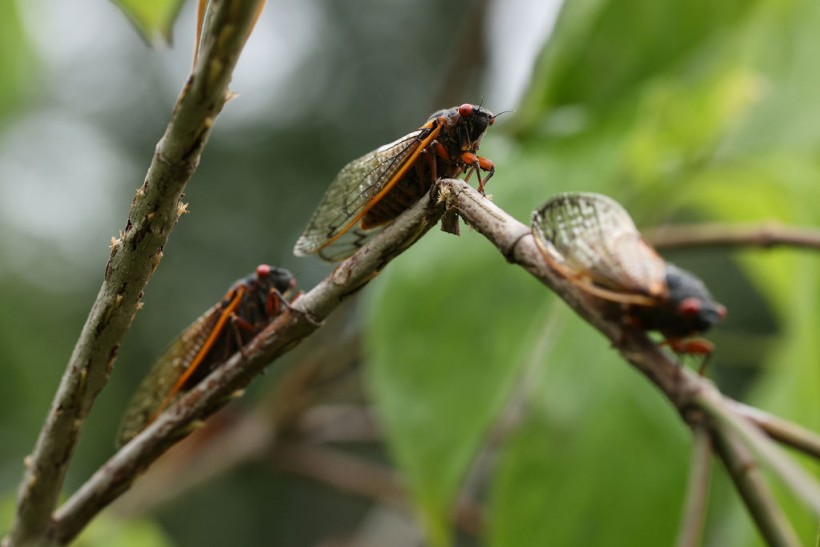The US faces a cicada 'apocalypse' with over a trillion insects emerging in a rare 200-year event. Two distinct cicada broods will simultaneously surface for the first time since the 19th century, spanning multiple states.
These noisy insects, known for their 13- or 17-year hibernation cycles, will mate and lay eggs. Dr. Gene Kritsky from Mount St. Joseph University describes this dual emergence as an extraordinary once-in-a-lifetime event.

Periodical cicadas, members of Brood X, climb on a small tree branch that broke after being weakened by cicadas laying their eggs under the bark on June 03, 2021 in Columbia, Maryland.
Cicada Apocalypse in 16 US States
Cicadas are set to make a remarkable appearance across several states, with only Illinois and Indiana having the privilege of witnessing both broods. This convergence of broods occurs approximately 12 times every 221 years, marking the first instance since 1803 that these two broods will emerge simultaneously.
Brood XIX, last seen in 2011, is poised to reappear in multiple states, including Alabama, Arkansas, Georgia, Illinois, Indiana, Kentucky, Louisiana, Mississippi, Missouri, North Carolina, Oklahoma, South Carolina, Tennessee, and Virginia. In contrast, Brood XIII, following a 17-year cycle, last emerged in 2007 and is expected in states like Illinois, Indiana, Iowa, and Wisconsin.
Comprising three different species, Brood XIX, known as the Northern Illinois Brood, contrasts with Brood XIII, or the Great Southern Brood, housing four distinct species. The emergence of Brood XIX is anticipated to commence in mid-May, primarily in Midwestern states.
Meanwhile, Brood XIII will start emerging from late April through the second week of May, reaching southern states first and gradually moving to Missouri, Kentucky, North Carolina, Virginia, and finally, in May, making appearances in Illinois, Missouri, Wisconsin, and Iowa by the third week.
America's Cicada 'apocalypse': 200-year event will see one trillion insects from two groups infest 16 states... and our map shows the hotspots | Daily Mail Online https://t.co/4GaaOFseQq
— Deplorable Ms B (@JoMahma4) January 22, 2024
READ ALSO: Expect Trillions of Brood X Cicada To Invade the US After Hibernation For 17 Years
Cicada Chronicles: Burrows, Lifespan, and Ecological Impact
Cicadas, belonging to the same family as stink bugs and bed bugs, reside in underground burrows for over a decade until maturation prompts their emergence. During the weeks preceding their emergence, the insects build tunnels but stay inside until soil temperatures at a depth of 7-8 inches reach around 64 degrees Fahrenheit.
What sets cicadas apart is their extended lifespan, although once above ground, their existence is fleeting, lasting merely four to six weeks for mating. Periodical cicadas, spanning 1-1.5 inches with a wingspan double that length, feature distinguishable orange veins and large red eyes.
Comprising seven species, three broods surface every 17 years, while the remaining emerge every 13 years. Some cicadas may deviate from their expected schedule, as seen in the early emergence of thousands in the year 2000.
While the insects' mating call may be bothersome, cicadas pose no threat to humans, lacking stinging or biting capabilities. According to the Environmental Protection Agency (EPA), cicadas serve as a valuable food source for birds and contribute to soil nutrition upon decomposition. However, they can potentially harm young trees if females choose to lay eggs in them. The EPA recommends protective measures like covering trees with mesh or netting featuring ¼-inch holes or smaller.
More so, Mount St. Joseph University suggests using cheesecloth to shield branches from cicadas. Importantly, cicadas do not harm flowers or fruit, solely consuming sap from trees and shrubs to sustain themselves. Pesticides are ineffective against cicadas.
Overall, cicadas offer ecological benefits by naturally aerating the soil through their emergence tunnels. The abundance of adult cicadas becomes a significant food source for various predators, positively influencing their populations, as stated by Cicada Safari.
RELATED ARTICLE: Gathering of the Cicadas: Once-in-a-Lifetime Phenomenon Unveils 221-Year Synchronized Emergence of Two Broods
Check out more news and information on Cicadas in Science Times.














